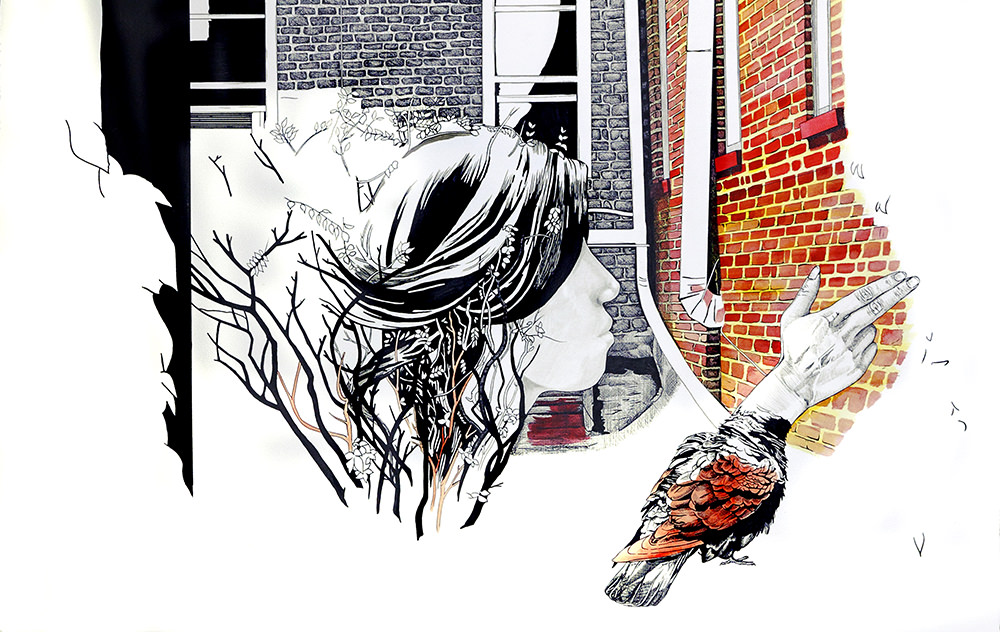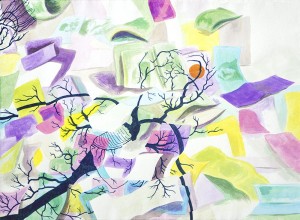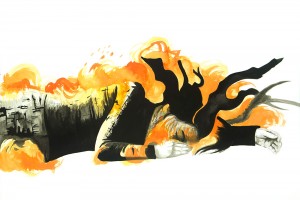I recently wrote an article called “The Myth of the Starving Artist—and what it can teach us about job security.” In it, I discuss how society’s attitude towards art parallels how people feel across industries about their jobs and companies. We’re in a culture that devalues creativity and values pursuing a paycheck over the purpose of what we do to earn that money.
The topic blew up on my social media accounts and I received responses from artists and non-artists alike. The most common feedback was on how the article challenged people’s existing assumptions on what is considered responsible or valuable to do for pay and with our lives.
Of course, recognizing the problem is only the first step. The responses made me start thinking about how to overcome this crippling mindset and stereotype, and how until we change it, we’ll continue to be at the mercy of what we’re given.
I won’t deny that we face a lot of obstacles. We can’t change the situation we’re dealt. But remember, we’re artists. We’re creative and resourceful, and so I’m writing today to figure out how we can collectively begin to shift the dialogue and culture we’re working in through the actions and decisions we make.
Paradigm Shift #1: Confidence is not a game. It’s a practice.
Your biases will determine not only how you think but also how you act and make decisions. A starving artist is not a confident person. The success of great work depends as much on confidence as talent, and that doesn’t just mean you need a better sales pitch.
Are you the most open-minded to new experiences when you are confident or insecure? If you expect to learn and further your skills as an artist, then you need to have confidence.
I often feel conflicted about campaigns like “support local artists.” I understand the intent, but I also think it perpetuates this idea that small is weak and that people are a charity case. But to create is to believe that you have something inside of you worth sharing. More than support, you need challenge, opportunity, and cultivation to hone your craft and deliver your message in a meaningful way.
So don’t shoot yourself in the foot early on by believing the end game is the empty plate of self-sacrifice. You’ll start to live the image instead of making great art.
Paradigm Shift #2: It doesn’t matter what you do for a living. It does matter how you define yourself. You’re an artist, and creativity is your strength, not a weakness. Use it to your advantage.
Even when I was working a 9 to 5 desk job, I saw myself as an artist. Even when I was working long hours and returning home too tired to think creatively anymore, let alone make art, I viewed what I was doing as a stepping stone to where I wanted to be. First, I was saving money. Second, I treated my job and workplace like art, like things I wanted to change and improve. Creativity, strong observational skills, and the readiness to do hands-on work are all advantages in today’s job market.
My approach as an artist made me unique, so I stood out. My willingness to work hard, try different things, and question the way we did things opened up new opportunities for me, even (or maybe especially) because I worked at a 100-year-old company that was set in its ways. As a result, I gained valuable skills and mentorship that challenged my own assumptions about what work can be. I eliminated the original position I was hired for, which freed me up to take on new roles. I learned about business operations and how to streamline and reduce waste. I learned how to both make and break the rules of a business model that I could later compare to what I now see in the arts industry. Perhaps most importantly, I worked with a lot of people who think very differently than I do, and this taught me to balance being a challenger of the status quo with the goal of finding common ground. Few things are quite as valuable to cultivate in yourself (or as difficult to live up to or as uncommon to find in others) as knowing how to disrupt and also make peace.
In short, doing something other than art changed my thinking, and in the long run made me better as an overall person, and therefore better at art.
I see a lot of artists take jobs that they’re complacent with. They see what they do as just a way to scrape by so they can make their art in the after hours. They don’t question or care about their jobs. You don’t have to do what I did. You do need to find what works for you. Complacency is the enemy of creativity. The moment any of us ceases to question is also the moment we cease to be artists. Art challenges perceptions. When we cease to question, culture stagnates and becomes toxic.
Remember who you are. You’re an artist, in anything you’re doing. It’ll both change the way you look at your day job and make you better as an artist outside of that job.
Paradigm Shift #3: Recognize that you are a leader. Remember, also, that leadership is a practiced skill, and that there are both good and bad leaders.
In anything you do, you’re setting an example. When you lack confidence in your artwork and let others dictate how it is used, you’re not just sabotaging yourself. You’re sabotaging the way others around you think about themselves and about artists. You’re teaching clients that it’s okay to exploit you and other artists that it’s normal to be exploited.
Here’s an illustration of what I mean. Think about all the time we spend preparing our resumes and CVs for job interviews. Competing in any job market is difficult. With all of this running around, it’s no wonder the job search is so discouraging and administrative costs for businesses are so high. But applying to most jobs, at least, is free. Now let’s look at the barrier of entry for an art opportunity, either for a show, a residency, or a grant. Many of these have application fees. On top of needing a resume, a CV, and a letter of intent, you also need to supply a portfolio (which is proof of all the work you’ve already done, not just what you say you’re capable of like on a resume) and pay a fee for the privilege of getting somebody to judge you, never mind compensate you should they deem your work worthy of being seen.
When I think about the amount of legwork other artists and I have done, it’s insane. Besides making the art itself, we’ve all built our own websites, professionally framed and photographed our artwork, highly researched the topics we’re interested in, tested out all types of materials and mediums, juggled multiple demanding projects, etc. We’re web developers, archivists, academic researchers, philosophers, project managers, and more all wrapped into one being.
And yet the process of getting our artwork in front of the right audiences is extremely difficult and designed at the disadvantage of the artist. In an amazing amount of irony, no other industry requires you to waste quite as much time pitching what you do as the arts. Is it unfair and are there people in the system who are abusing their power? Yes, totally. But the starving artist mindset allows this to perpetuate. Remember what I wrote earlier about confidence? Until artists build confidence and learn to stand up for the value of their work, this isn’t going to change. True, there are lots of things you should say, “Yes,” to, especially considering how much creativity benefits from the collaborative spirit. But artists also need to know when to say, “No,” to exploitations disguised as opportunities.
Which brings me to my final point…
Paradigm Shift #4: To create well, you need to know when to stop creating.
One of the reasons the art world is so upside down is there’s just so much choice. We’re in a culture that pressures us to be busy, to produce more not out of need but rather to validate what we’re doing. Yes, it’s important to create for the sake of exploration and learning, but I shouldn’t need to explain to you the difference in how you feel when you’re creative versus staying busy, and truth be told, there’s a lot of crap out there as a result of the latter. The busier you are, the less time you have to think, and the end of thought is the end of artistry. The thought you put into your work is what makes it more than a pretty shell and gives it substance and power.
Going back to how art impacts your career, the strength of my identity as an artist is both what made me good at my former job and recognize when it was time to leave. It would have been really easy to stay either at that job or on the same career track. But I didn’t forget the big picture of who I am and what made me great at questioning things in the first place.
If I could boil all my reasoning for leaving my former job down to one thing, it’s that I recognized a mismatch between my own values and that of the leadership and work culture. I worked at a printing company, but we had no art on the walls. Our offices and machines were painted brown and grey. I would bring in my favorite books on the history of print to show the artistry of what we were doing, but neither my peers nor managers saw what I see in those books. The company has three work shifts to make the most of our manufacturing productivity. My coworkers were “always busy,” but very few were truly ever curious about the how’s and the why’s of what we were making. The leadership’s strategic goals included reducing lead times and growing the business by 30%. Yes, the leadership was pushing us to be more efficient with our resources, which I approved of, but the purpose wasn’t to open our time up for more curiosity and exploration or to go home and spend time with our families. It was to be able to do more work in less time, and therefore take on more work (anyone ever heard of Jevons paradox?). The company is sales-driven, and while the bottom line is important for all businesses, a business driven by sales is led by the dollar, not by the craft.
There’s nothing inherently wrong with those goals and desires. But I realized that it would be a long time, if it even happens in the span of my career, that the leadership and culture of that company would become one that values art and its role in changing the way we see and live. It wasn’t a place where I could grow anymore, not in the way I needed or would have made the best of what my creativity could do for my colleagues and mentors. In the long run, I would have been doing them and myself a disservice by staying to do work that I didn’t believe in.
If you’ve noticed something throughout this article, at a certain point, it’s not so much about the art as the people we become because of it. The ability to create great art comes from both a great awareness of yourself and what surrounds you.
That awareness is also what gives you the strength of voice to be able to say this is–and this is not the work for me–for the right motivations. That’s not something a lot of people ever learn how to do, but I bet you the world would look quite different if more of us did.
What you create has power. How you see yourself will determine the way that power gets used. So I leave you with this. Will you continue to see yourself as the starving and the disempowered, and let others use your talent to build a world that you can neither believe nor survive in? Or will you choose to believe that you, as an artist, are powerful, with the skills, the mind, and the message for producing great work, the kind of work that makes you a leader of the creative culture we can become?
**The cover image is “The Substance of Your Beauty” (formerly entitled “For Your Charming Lack of Content”), 20 x 30 inch ink & watercolor drawing by Jenie Gao.
**This post has also since been republished on The Abundant Artist.





Heck yes! Reading this made me feel awesome. Thank you! Artists do so MUCH! Great perspective on shifting your mindset from lack to plenty/ victim to power.
Thanks, Anne Marie! It means a lot to know this article had an impact. Thanks for reading, keep creating, and stay in touch. :)
Absolutely the most effective encounter of how my heart feels regarding my creativity that I have to give this world. Thank for for the time it took to collect and present these words. It was much needed abs appreciated.
Wow. You get it, Jenie. I feel very strongly about valuing my day job. I value the opportunity for social interaction and I continue to learn from my colleagues. I believe we continuously arrive at moments of readiness. I will be ready to devote myself exclusively to art at some point. More importantly, I focus on what I am ready for today! That focus is a huge source of daily joy!
Best regards,
Dan
This is a powerful article; thanks so much for sharing. Remembering that each of us has a unique perspective and creative expression helps bolster the sense of confidence you spoke of . So often it’s our opinions of ourselves that holds us back . Change the story you repeat in your mind and you can change your life.
Of course, I never wanted to be a starving artist, but unfortunately the opposite of that was always far worse: a “sell out.” Eeek. I also never realized that the phrase “support local artists” was so disempowering. Thank you for these points, I am now having to rethink some things about my own language and thought process.
You proved with this ideas that artists are philosophers just like you. it’s critical for artists to well-know their power and potentiality as well as being confident. Thank you so much, and for notice I work on a printer too!! :-)